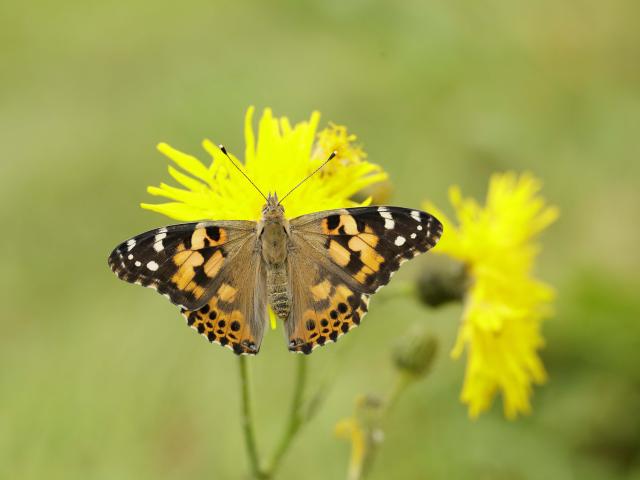Central London is not where you’d go looking for memorable butterfly experiences. But then, one of the joys of watching butterflies is their capacity to surprise.
It was just a family picnic in Hyde Park, somewhere to let the kids run around, while we were up in London visiting my brother. As we passed the Albert Memorial, I noticed a few Painted Ladies feeding avidly on a stunning bed of Perennial Wallflowers. It was the end of May 2009, Bank Holiday weekend, so the sighting was welcome though not extraordinary.
What followed, however, certainly was in the latter category. As we sat in the long grass, I saw a Painted Lady fly past in such a direct, insistent manner that I immediately thought ‘migration’. Sure enough, a minute or so later, another one passed, apparently on the exact same flight path. This was it – my first ever experience of a Painted Lady mass migration. It was not spectacular, hardly noticed by those around me, but an incredible and moving experience for me, as one or two butterflies passed us every minute for the next hour or so, each travelling northward along the same invisible corridor. I’ll never forget it. By the end of the day the phone was ringing and there was already a media buzz about the phenomenon that was being witnessed from the wildest stretch of eastern coast to the centre of the capital.
The months that followed were busy and exciting as Butterfly Conservation members and the public recorded their Painted Lady sightings via our online survey and the media went butterfly crazy.
Journalists, interviewers, friends and colleagues asked a hundred and one questions – where do they come from, why do they migrate and how can such small, seemingly delicate creatures achieve such a feat? Much was already understood – the general northern spread from warmer parts of Europe and North Africa had been known for decades and recent studies of Monarch butterflies, another consummate traveller, had uncovered extraordinary abilities to navigate using the sun and a neurological clock to correct for the daily movement of the sun across the sky. If Monarchs could do this, why not Painted Ladies?

The tricky question was what happens next? It simply wasn’t known whether UK Painted Ladies, reared here in the summer and autumn, undertook a southward migration or simply perished in the British winter. It seemed logical that they should go, but despite centuries of observation Painted Ladies have hardly ever been seen leaving the south coast in autumn.
Could it be that Britain was simply an evolutionary dead end for those Painted Ladies that ended up here – the so-called Pied Piper phenomenon?
It has taken another three and a half years to deal with that question. The 2009 Painted Lady year fired not only the imagination of butterfly watchers in the UK, but that of butterfly scientists across Europe. At the Butterfly Conservation Symposium the following spring, plans were laid to examine Painted Lady sightings from across the continent, as well as data from Rothamsted Research’s entomological radar, in an attempt to understand fully the 2009 migration.
It has been a long road, but in October the results were finally published. Over 60,000 Painted Lady sightings from across Europe and North Africa, together with vital radar data, enabled us to piece together the amazing travels of this incredible insect.
It undertakes an annual round-trip of up to 9,000 miles between sub-Saharan Africa and the Arctic Circle (almost double the distance of the famous Monarch migration in North America). The journey is a series of steps, each leg undertaken by a successive generation.
The Painted Ladies I witnessed speeding across Hyde Park had come from southern Europe, probably Spain and Portugal. Their offspring, which abounded in the summer, then emigrated back to Africa. At the same time, however, a new influx of Painted Ladies arrived in the UK from northern Europe to begin breeding. Their offspring, which emerged in October, then continued the journey south.
 Why did we not see them leave? Well, the Rothamsted radar showed that migrating Painted Ladies fly at altitude, where they cannot be seen by observers on the ground. The radar recorded large numbers of high-altitude Painted Ladies heading south over southern England in late summer and autumn 2009. Most were over 350m above ground level, with some over 1km high.
Why did we not see them leave? Well, the Rothamsted radar showed that migrating Painted Ladies fly at altitude, where they cannot be seen by observers on the ground. The radar recorded large numbers of high-altitude Painted Ladies heading south over southern England in late summer and autumn 2009. Most were over 350m above ground level, with some over 1km high.
These insects made use of favourable winds to achieve average speeds of c.30 mph, more than twice their capability under their own steam.
We may be unravelling some of the mysteries of Painted Lady migration, but these breakthroughs make the phenomenon all the more amazing, enhancing memories and lending excitement to the next big arrival. Perhaps 2013 will be the year.
Richard Fox
Surveys Manager
Twitter: @RichardFoxBC


